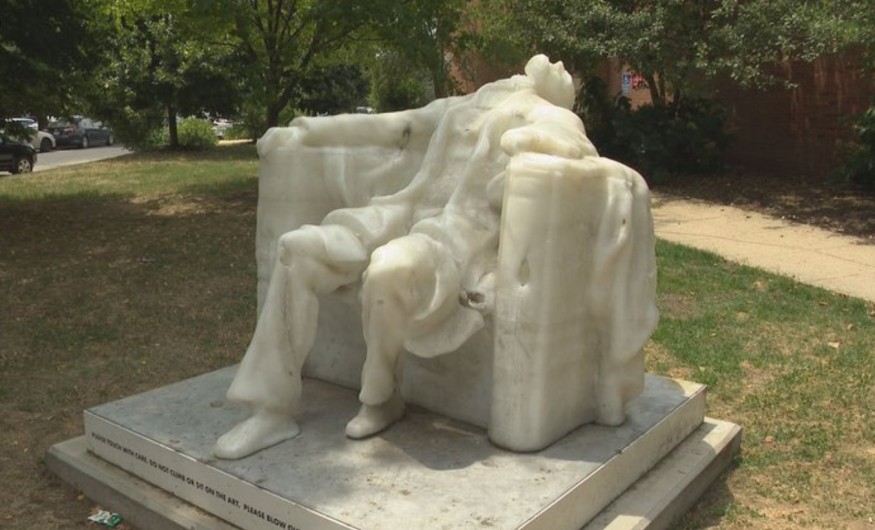Abraham Lincoln's Wax Sculpture Melts in Washington Heatwave

A scorching heat wave that has continued to wreak havoc in the nation's capital has also led to the melting of the wax figure of former president Abraham Lincoln. The statue, placed in the historical area of Camp Barker, melted due to the Record temperature exceeding the limit for the past few days, which reached 37 degrees Celsius or 98.6 degrees Fahrenheit.
Background and Significance
The life-like wax figure that was supposed to depict a black soldier, designed by CulturalDC nonprofit, was installed in the center of the place that once used to be a refugee camp for freed African Americans and enslaved people during the Civil War. Originally designed to commemorate Lincoln and the period it characterized, the statue was to remain through September 2024.
However, the unprecedented heat wave had other plans. Witnesses reported that the statue's head was the first part to deform and collapse under the intense heat, soon followed by the legs. The BBC confirmed that the disfigurement was rapid, with the once-majestic figure of Lincoln reduced to an unrecognizable shape within hours.
Artistic Elements
The sculpture, created by US-based artist Sandy Williams as part of the Wax Monument Series, was not just a static display. Intriguingly, it incorporated a functional candle, accompanied by a plaque instructing visitors to "please blow out your wick within 1-2 minutes." This interactive element aimed to engage visitors in a reflective act, symbolizing the fragility of freedom and democracy.
Also Read : Lim Oon Kuin, Former Oil Tycoon, Lists $32 Million Singapore Mansion During Legal Troubles
CulturalDC, known for its innovative approach to public art, expressed disappointment but maintained a sense of humor in its official statement. "Whether it's the state of the union, the upcoming election, or this record-level heat, we are all over it!" the organization remarked. CulturalDC has assured the public that efforts are underway to repair the sculpture despite the setback.
WE CAN NOT WITH THIS HEAT EITHER, LINCOLN
— Cultural_DC (@Cultural_DC) June 25, 2024
Our project, “40 ACRES: Camp Barker” by Sandy Williams IV has gone viral (for innocent reasons and some not so innocent ones). Read the articles for yourself: https://t.co/NfRc0CaLQI
Check out our website for updates. #waxlincoln pic.twitter.com/688QcBUAj2
Broader Implications and Historical Context
The melting statue of Lincoln has received a lot of publicity, and rightly so, because it highlights the impacts of climate change. Like in many other parts of the globe, Washington D. C. is now suffering from high temperatures, and people are already questioning the sustainability of outdoor sculptures and artwork placed in that area, given the rise in the effects of global warming.
Camp Barker, where an elementary school currently stands, is a historical structure. The wax statue display was also educational, ensuring young students and visitors understood the difference between the past and the present. This event has informed the need to devise measures to preserve such cultural icons within the context of growing and volatile climate patterns.
Restoration Plans
Current outlooks for the statue are to repair it, find a more suitable form of containing the heated rod, or find a more relaxed environment to put the tube within. However, the current puddle of metal has gotten a lot of attention from people. It has been a platform for discussing history, art, senseless suffering, and the need to fight Climate change.
That is why, as the process of cleaning and restoration is being launched, the community is coming together to ensure that the art and the meaning behind it remain unbroken. Although unfortunate, the ire of Abraham Lincoln's wax figure melting is as if ironically strengthening its relevance as a work of art, as it underlines how fragile the line between remembrance and reckoning in the future is.
The melting of the wax figure of Abraham Lincoln in Washington D. C., although symbolic of the real effects of climate change, also explains the tenacity and versatility of art and history. The action of CulturalDC in an attempt to restore the statue is informative of the passion of the American people for fixing their past in acknowledgment of the present woes. When restoration work starts, the significance of the lost artifacts for the people and the conversation regarding climate change and its impact remains a testament to the communities' commitment to preserving cultural memory. It is a shocking reminder of the need for new approaches to creating public art objects and a wake-up call to try to reverse the impact of a heating planet.












